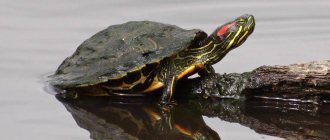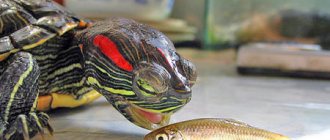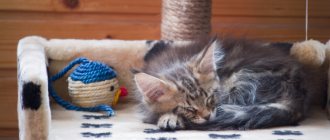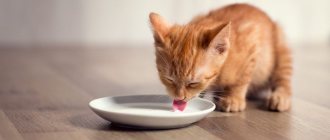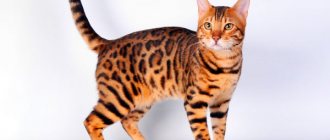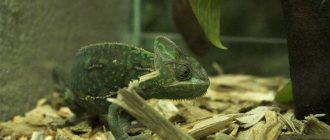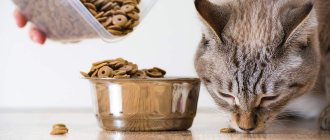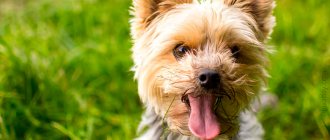Review author: “ZooVita”
Turtles are quite demanding and difficult reptiles to keep. And this applies, first of all, to their diet. Modern pet food manufacturers offer turtle owners a wide variety of “balanced” foods that make caring for their pet much easier.
However, in order to choose the right basic and additional diet and bait, it is necessary to understand in more detail what you can feed the turtle.
What do turtles eat in the wild?
The main component of the diet of red-eared turtles in the wild are shellfish: mussels and snails, oysters, and crustaceans. They have no teeth, but this does not prevent them from excellently dealing with mollusk shells: with strong jaws they break them and eat the pulp.
In the summer, insects become food for turtles: grasshoppers, beetles, etc.
They are very fond of algae, plankton and small fish. They also eat tadpoles, fish fry and frogs.
Treats
Supplement the diet of land reptiles:
- champignons, puffballs, oyster mushrooms and other easily digestible mushrooms;
- sunflower seeds;
- bran;
- mango;
- plums;
- peaches;
- beets;
- boiled chicken or quail eggs;
- snails and slugs - once every few weeks.
Feed adult aquatic turtles:
- raw lean meat;
- baby frogs;
- tadpoles;
- chicken, fish, beef liver;
- shrimp;
- octopus tentacles;
- mussels.
Diet of the red-eared slider
A necessary aspect of caring for turtles is preparing the right diet. The health of your pet depends on feeding high-quality, fresh and, importantly, varied food. How the red-eared turtle feeds, how long it lives, and how it feels are closely interconnected.
In captivity, this reptile has little demand for food. For a tough shell and healthy skin, reptiles require both plant and animal products. For turtles up to one year old, the latter must be included in the diet in an amount of 80% or more.
A reptile's hard shell requires plant and animal products.
Mature turtles need to increase the amount of plant foods rich in fiber and vitamins. As a result of eating only meat, pets can develop rickets, hypovitaminosis or obesity.
The required vitamins and dietary supplements must be regularly added to food.
Recommendations for how many times per day to feed your red-eared slider will depend on the age and preferences of the individual reptile.
If the turtle is up to 1-1.5 years old, there should be one or two meals a day. If you have no appetite, reduce the amount of food or go on a short hunger strike for 1-2 days.
To create an optimal nutritional regimen for an adult, you should observe the pet and feed it on demand. If a turtle is hungry, it becomes overly active in the presence of its owner, hitting the water with its paws. After feeding, she calms down and rests calmly. A turtle may require food daily, or maybe once every 7 days.
How to find out age
Unfortunately, sometimes even store salespeople are unable to accurately tell the age of a red-eared turtle, so owners have to deal with this issue on their own. The following data will help you find out the age of a reptile:
- 2 years – females 8-9 cm, males – 7-8 cm.
- 3 years – females 10-14 cm, males – 8-10 cm.
- 4 years – females 13-16 cm, males – 12-14 cm.
In addition to calculating age based on pet size, you can find out the approximate number of years in the following way:
- Shell color - in young turtles the coating is green. After 4 years of life, the shell begins to darken; in older reptiles the cover is almost black.
- Rings – rings are formed on the shell when reptiles reach one year, 2-3 rings are added every six months. After 4 years of life, the ring appears once a year. By counting the number of rings, you can roughly estimate the age of the turtle.
Basic feeding rules
To properly feed a red-eared turtle, you must comply with the basic conditions and some subtleties:
- Any food needs to be cut into pieces: the smaller the turtle, the smaller the pieces.
Any food needs to be cut into pieces
- Aquatic reptiles tear large pieces with their sharp claws, so that plant food can be fed whole.
- Before serving, products must be washed, seeds and peels removed.
- The pet should eat the food within 30 minutes. The serving size should be calculated based on this indicator, and should not exceed half the size of the shell. You can also give pieces of food the size of the reptile's head.
- Feed should be given at room temperature. Very cold food is harmful to your pet's health.
- Turtles search for food using their vision. The more attractive the color of the food, the faster she will find and eat it. For this you can use carrots and tomatoes.
- It is better to feed your pet in the morning, but it is not essential. It is important that she has time to digest what she eats during daylight hours or with the lamp on.
- Uneaten food must be immediately removed from the reservoir - this way the reptile will develop the habit of eating at certain hours.
There are different ways to feed armored animals: with tweezers, from a special bowl, or by throwing them into water.
You can feed red-eared turtles with tweezers
It is best to feed the red ear in another aquarium or basin, because leftover food will contaminate the terrarium, and the water will have to be replaced frequently.
You can also teach him to eat on an island equipped in the aquarium. First, food is placed at the very edge of the shore near the water. If the reptile is hungry, it will have to take food. So gradually get used to eating from a small saucer with water.
You should not hand feed your reptile too often to avoid getting used to this method of feeding and refusing to eat differently. There is also a risk of being bitten.
You cannot distract your pet while eating: sudden movements and loud sounds frighten him.
Food
The favorite food of ordinary musk turtles is small fish, aquatic insects, mollusks, shrimp, algae; these reptiles do not disdain a variety of carrion, for which they have earned a reputation as orderlies of reservoirs.
If a musk turtle lives in a home terrarium, then, given its taste preferences, there is a high probability of contamination of the water with food debris, so for feeding it is recommended to use tweezers or special needles adapted for threading food. Most likely, the turtle will not immediately understand the purpose of such devices, but if you wave a tasty piece of meat in front of its nose, it will get used to it quite quickly. Mobile young individuals can begin hunting for small fish kept in the same aquaterarium, for example, guppies.
What can you feed your red-eared slider?
At home, you can use special food purchased at a pet store to feed your red-eared reptile. If your pet shows signs of illness, for example, a red-eared slider's shell is peeling off, you should pay attention to the quality of its diet.
For the main diet, meat and offal, cottage cheese and eggs are used, as well as fish, seafood and insects. The use of various types of plants, vitamin and mineral supplements is recommended.
Animal feed
This food serves as the basis for the diet of aquatic turtles. For a growing animal, the portion size and variety of food should be increased.
Red-eared turtles prefer live food: snails, small fish, insects and crustaceans. Such nutritional components will be good for diversifying your diet, but you shouldn’t get too carried away with them. It is enough to apply them 2 times a month.
Red-eared turtles prefer live food, but you shouldn’t get carried away with it
Food can be served either raw or cooked, unsalted and unseasoned, divided into pieces.
Meat
The red-eared slider's diet may include lean beef, horse meat, rabbit, chicken and turkey.
Reptiles also eat minced meat. Finely chopped plant food is added there if the turtle refuses it.
By-products
By-products should be added systematically to the red ear's diet. From a wide variety, you should choose only beef or poultry liver and heart. They contain a significant amount of vitamin A, which helps normalize the growth of the pet and maintain healthy skin. Due to a deficiency of this vitamin, detachment of the horny scutes, development of conjunctivitis, etc. are possible.
By-products should be added to the diet systematically
It is recommended to give liver only to adult turtles once every 30 days.
Cottage cheese and eggs
It is difficult to feed cottage cheese to replenish calcium levels to a turtle - it disintegrates in water. But they like to catch it and eat it.
Eggs are used raw, mixed with various types of products.
Fish and seafood
Fish is recommended in raw low-fat varieties (up to 3.0%), such as hake, blue whiting, pollock and cod, and freshwater perch. River species are best suited.
Before feeding, you can remove large bones from the fish, but leave the giblets, because the turtle needs all the useful substances contained in the fish to maintain the rigidity of the shell and skeleton as a whole.
In order to eliminate the negative effects of thiaminase in raw fish, immediately before feeding, it is necessary to put it in hot water for 2 minutes.
Among marine products, green shrimp are used as food for reptiles; they enjoy octopus and squid, and eat mussels and snails.
Reptiles enjoy eating octopus, squid, and shrimp.
If there are fish or frogs living with the turtle, there is a high chance that it will eat them.
Insects
The menu of the red-eared turtle should include insects: beetles and hairless caterpillars. He loves to eat grasshoppers and crickets, earthworms, and also eats mealy bug larvae.
In summer they are collected in the garden and park. But you can’t collect it where it has been treated with chemicals.
Cockroaches caught at home should absolutely not be given in order to avoid insecticide poisoning.
Pet stores sell bloodworms and mealworms to feed armored reptiles.
It is recommended to purchase gammarus - small dried crustaceans. It contains a significant amount of calcium. Koretra and daphnia are also suitable food for your pet.
Insects are used as food for the turtle 1-2 times a week.
Fruits
All types of fruits contain many vitamins.
To the question whether a red-eared turtle can have an apple, there is one answer - you can also have a pear, a banana, an orange and a peach, or a plum and an apricot. Only citrus fruits should be peeled.
You can give your red-eared turtle apple, pear, banana and other fruits.
It is also recommended to occasionally give strawberries, wild strawberries, and pamper your pet with raspberries and other berries. The turtle can also have melon and watermelon.
Vegetables
Vegetables are rich in fiber, which is very beneficial for the gastrointestinal tract, and in particular, the process of food absorption, as well as vitamins A and K, calcium.
These reptiles eat cucumbers, zucchini, cabbage leaves, and red tomatoes, bright sweet peppers, pumpkins, carrots and beets attract their attention. You can even offer beans and asparagus.
They are given raw, without signs of spoilage and without mold. Cooked vegetables have no benefit for the turtle.
Mushrooms
Along with vegetable and fruit food, the red ear can be fed once every 7 days with mushrooms: slices of russula, champignons and boletus.
Greens and plants
These products are also important in the diet of turtles. They must consume them at least 50% of the total diet, and for older turtles this figure reaches 75%.
It is also recommended to feed these reptiles indoor plants, for example, thornless cacti and agave, tradescantia, hyacinth and hibiscus. It is very useful to feed with herbs from meadows, dandelion, coltsfoot, as well as plantain and clover. These reptiles have a good appetite for carrot and beet tops, lettuce leaves, basil and parsley, and dry hay. It is recommended to feed with sprouted wheat or oats (cut sprouts 5-10 cm).
These reptiles have a good appetite for carrot and beet tops. The greens are torn in the garden or in the forest far from roads, sorted and washed.
Aquatic plants, for example, duckweed, hornwort, pistia, water hyacinth, etc. are extremely useful for these reptiles.
It is better to breed them separately. After all, the algae growing in an aquarium with red ear is constantly plucked by it, which disrupts the landscape design. Having eaten algae, she may not accept other food.
Duckweed can be caught from a nearby pond.
Toxic algae (elodea and limnophila) are destructive to turtles.
Food in winter
The change of season is reflected in nutrition. In the summer, feed herbivores and omnivores with greens, vegetables and fruits. Turtles eat frequently and have small portions. In cold weather, reptiles are content with frozen foods and hay; they eat rarely, but in large quantities.
You can plant plants in pots, this will provide the turtles with fresh greens to eat in the winter. Propagate plants such as duckweed or hornwort so that turtles can be fed aquarium flora continuously. To do this, you will need to purchase a separate aquarium and properly care for the plants.
Artificial feed
Pet stores have a wide variety of balanced foods specifically for armored reptiles. They can come in various forms: capsules, tablets, granules and even flakes. And their compositions will vary. But for the most part, the food produced by the manufacturer often does not satisfy all the needs of the reptile’s body.
In essence, turtle food is food for aquarium fish that has been improved to meet the needs of the reptile's body. Due to the specific smell, pets may even ignore it, but over time they get used to it.
This type of feeding is convenient, but you cannot feed it alone
This type of feeding is convenient primarily for busy people, but it is not the only way to feed. Such feeds often do not maintain the balance recommended by veterinarians, which can lead to vitamin deficiency and digestive problems for the animal.
Mineral mixtures and vitamins
It is necessary to feed the aquatic turtle with vitamin and mineral mixtures. Active growth, healthy skin, and proper development of the skeleton and bone tissue depend on them.
Aquatic turtles receive useful substances not only from a variety of foods, but also from special supplements. The diet of such a pet should contain moderate amounts of vitamins A, B12, D3, E, as well as minerals such as selenium and calcium.
Regular feeding with calcium-containing preparations is especially important for turtles to strengthen their shells, especially in growing young individuals. With calcium deficiency, it can become crooked and lumpy. Claws may also become bent, limbs may occasionally break, and in extreme cases, the shell may even fall apart or become like cardboard. In nature, sources of calcium for turtles are limestone, oyster shells, corals, dolomites, and animal bones.
Calcium-rich foods include the popular gammarus. A significant amount of it is found in bone meal, ground egg shells, and also in feed chalk. They are given 100 mg of the mixture per 1 kg of pet’s weight once every 7 days.
The most applicable drugs are purchased at a veterinary pharmacy or pet store.
Feed containing vitamins and minerals (except calcium) cannot be stored for a long time. Vitamins for the prevention of vitamin deficiency C and E and mineral supplements are given only once a month, mixed into the food.
Vitamins and mineral supplements are given only once a month, mixed into the food
To ensure that the turtle consumes all the added nutrients, you should mix them with food and feed them by hand.
Ready-made food in a pet store
Dry food for red-eared turtles can be used only in cases where it is not possible to maintain a balanced diet using natural products.
Although manufacturers promise to fully satisfy the reptile’s needs for the necessary substances, they do not recommend making semi-finished products a monotypic type of food in order to avoid metabolic disorders and problems in the gastrointestinal tract.
Food for cats and dogs
It is not recommended to use either dry or wet dog or cat food for feeding red-eared turtles.
This combination food is specially developed in the optimal ratio for feeding warm-blooded animals, so it is not suitable for reptiles. It contains a set of substances that are absolutely useless for turtles.
Vitamin and mineral supplements for these pets also do not meet the needs of the turtle’s body.
Homemade food for red-eared turtles
It is possible to prepare food for pets with shells yourself at home.
For this you will need:
- cabbage – 50 g;
- squid meat – 100 g;
- lean fish – 145 g;
- carrots – 70 g;
- apples – 50 g.
Grind all the components using a meat grinder, break 2 eggs into it. Dilute 30 g of gelatin in 150 ml of hot water. Mix all ingredients thoroughly with 150 ml. milk.
Grind all components of the feed using a meat grinder
Keep in the refrigerator for 7 days only. Feed in small pieces. This food is enough for 10 meals for one turtle with a shell length of 15 cm.
If you replace gelatin with agar-agar, the food will dissolve more slowly in water.
Here's another recipe for making your own food.
Take the following products:
- squid – 0.3 kg;
- pollock – 1 kg;
- shrimp – 0.5 kg;
- gelatin or agar-agar – 150 g;
- hake – 1 kg;
- water – 750 ml.
Prepare the mixture as follows:
- Grind fish and seafood in a meat grinder.
- Dissolve agar-agar in water and let it swell.
- Mix the resulting minced meat well and heat over low heat for 10 minutes.
- Add dissolved agar-agar, mix thoroughly for 15 minutes.
- Pour the prepared mixture onto a baking sheet or into a plastic container and let it cool completely.
- Place on the refrigerator shelf for 5 hours.
- Cut the resulting mass into small pieces, wrap each in a piece of foil.
- Place them in the freezer.
For feeding, a portion of frozen food is taken out 4 hours in advance and thawed at room temperature.
The food is taken out 4 hours in advance and thawed at room temperature.
This supply will be enough for a red-eared pet with a shell size of 20 cm for a whole year.
Variety of choices
The usual length of small turtles is from seven to thirteen centimeters. When buying a water baby about five centimeters, you need to understand in advance that it may increase slightly in size over time. Several types of turtles are well suited for quickly adapting to home keeping.
Musk (Sternoterus)
It is a representative of the genus of mud turtles, and the smallest specimen. Its length does not exceed fourteen centimeters, and the average size of the shell is seven centimeters.
A special feature of the musk turtle's structure is its long neck. She can easily reach her hind legs with her jaw. Its carapace is smooth, but at an early age there are three clearly visible grooves on it. The turtle has a dark, uniform color, only light stripes are present on the head.
This turtle has a long neck
In its natural environment, this waterfowl lives in the south and east of the United States, and much less often in Canada. Small reptiles prefer freshwater bodies of water with muddy bottoms. They spend most of their lives in water.
Spotted (Clemmys guttata)
A fairly common species of turtle among exotic lovers. Domestic aquatic little beauties are recognizable by yellow spots located along the entire plane of the carapace - the dorsal shield of the turtle shell. Such spots are also present on the head, neck and paws.
This species can reach a length of no more than twelve centimeters. The neck of this turtle is quite short. Spotted turtles have a creamy-yellow ventral shield (plastron) with large black spots over the entire area.
In their natural environment, these creatures live almost throughout the Atlantic coast of the United States. Rarely found in Canada. In living conditions, they prefer swamps, small rivers with silted bottoms, and swampy wooded areas. They overwinter on the muddy bottom of reservoirs.
12 cm is the maximum height of this turtle
Flat (Platemys platycephala)
It is a species of the snake-necked turtle family, as well as the only representative of the species of flat turtles. The usual body length is 14-15 centimeters, rare specimens reach eighteen.
This cute version of small aquarium turtles features an orange and yellow head pattern that resembles a crown. The carapace in babies is dark brown with a yellow edging, and the plastron is yellow. This color scheme often plays a decisive role in deciding whether to keep this species at home.
The only species of the genus flat turtles, which previously also included some other species of the family.
The turtle has a long neck with small spines. The dark tail and paws contrast beautifully with the variegated color of the smooth and somewhat flattened shell. The chin is decorated with a cute mustache.
This species often lives at home due to its bright appearance and calm nature. Flat turtles can be kept several times in one aquarium. The calm environment can only be disturbed by males during the mating season.
Reeves pond turtle
This species (Chinemys reevesii) is often found in domestic pet stores. The length of the oval-shaped shell in adults does not exceed thirteen centimeters, so they can be kept in an aquarium without any problems.
The carapace of the Reeves pond turtle can be of different colors: yellow-brown, dark brown, black. The legs and neck are usually black, gray-green or olive in color with white or yellow lines on the sides.
This species of small pet turtles has a peaceful nature. It is allowed to keep several specimens in one aquarium. The pond turtle is diurnal and can provide many funny moments to its owners. It tames very quickly, each specimen has an individual character.
These turtles are peaceful
The Reeves pond turtle is native to China and Japan, and less commonly found in Taiwan and Korea. Natural habitats include ponds and streams. In sunny times, Reeves likes to crawl out onto clay and sandbanks.
What not to feed
These aquatic reptiles eat whatever is offered to them. But they cannot digest all the food they eat, which leads to disruptions in the gastrointestinal tract and, consequently, to diseases.
What not to give to a turtle:
- fruits and berries with seeds;
- food from the table;
- sea fish;
- fatty freshwater fish;
- citrus peel;
- flour products;
- onion, radish;
- Turtles have difficulty digesting pork and lamb fatty meat;
- poisonous elodea;
- amber snails.
You should not give a lot or often tomatoes, cabbage, legumes, spinach.
Herbivores
Any vegetables, fruits, root vegetables or greens can be used as the main diet. Starting from dandelions and carrots (clover, thistle, alfalfa, regular lawn grass) and ending with a variety of lettuce, carrots, cabbage, etc.
When preparing a diet, take 2-3 times more greens than fruits and vegetables. As additives to the main food of herbivorous turtles, you can use bran, dry yeast or dried seaweed, and soybean chaff.
What can overfeeding cause?
An important condition for the nutrition of a red-eared pet is not only a variety of diet, but also a regime. Overfeeding leads to diseases: pyramidal shell and obesity.
Not only the diet, but also the regimen is considered an important condition for nutrition.
Overeating in juveniles is extremely harmful, because they are actively developing, as well as during the adaptation period after purchasing or after illness of a red-eared turtle.
It is not recommended to force feed turtles. But long-term fasting is also contraindicated for them.
A healthy reptile should swim freely in the water and easily crawl onto the island. Excess weight will prevent the turtle from hiding its head in its shell.
Health and illness
More than 85% of all diseases of red-eared turtles are the result of improper care, maintenance and feeding, and most often all at once.
Maintaining clean water and the right temperature for your pet is as easy as creating the right conditions.
Here are the basics to help you keep your turtle healthy:
- Sick turtles should be kept at a higher temperature, in most cases 27-30 Celsius. At this temperature, the immune system operates at its peak efficiency. It is important to maintain fluid balance in the turtle's body so that it does not become dehydrated. Ensuring that she drinks and is in water is more important than her nutrition, since a sick turtle can die from dehydration and its kidneys will fail. Even in emaciated turtles, fluid balance is first restored, and then feeding begins.
- A sick turtle swims poorly, swims on one side, and may even drown. Reduce the water level and make sure she can come ashore as soon as she wants.
- If you suspect an infection, immediately isolate the animal and be sure to wash your hands after handling it.
- The basis for success in treating a turtle is contacting a specialist. Do not treat the animal yourself, go to the veterinarian!
Drinking regime
Red-eared turtles from the family of freshwater turtles live in the wild in small lakes with well-warmed water by the sun or ponds with swampy shores. For these reptiles, fresh water is vital (they cannot live without it for even a couple of days). The redfish spends its entire life in water - activity and sleep, eating and the process of defecation.
The red-eared turtle spends its entire life in water - activity, sleep, eating
The question of whether a turtle has a need to drink has not been fully studied. The structural features of her body do not allow water to linger: in the process of drinking, it pours out of her nostrils and flows down her neck. Moisture, so necessary for reptiles, penetrates through its skin, as well as from the products it eats.
Reproduction
Mating occurs in conditions of satiety, warmth and humidity all year round. It is recommended, a couple of months before the expected mating season, to place males and females in different enclosures, and preferably rooms, so that the animals do not see each other. It is recommended to place males with females.
A turtle's pregnancy can last from a week to two months. If the female is not satisfied with the conditions for laying eggs, she is restless and may refuse to eat. A few days before laying, the female will begin to look for a suitable place and dig the soil. It is recommended to organize a special box.
Eggs can be different in shape, round and oval, white and yellowish. Incubation of eggs lasts about two months. It is strongly recommended to move the eggs into a special incubator and check them daily for spoilage - rotten eggs may appear and ruin the entire clutch. The female is not interested in the clutch; further care of the babies falls on the owner.
How to determine gender
Gender is established at the stage of embryo formation in the egg. However, in most cases it is possible to accurately determine sex only after the animal reaches sexual maturity and the appearance of secondary sexual characteristics. Typically, at home, a turtle reaches maturity at the age of 2.5 to 5 years, depending on the species and conditions of detention.
There are a number of procedures that can help reveal gender earlier, such as:
- blood test for a certain number of hormones;
- radiography;
- Ultrasound;
- endoscopy.
Often such studies are uninformative and costly, and are resorted to in especially rare cases.
Let's look at how the sex of an animal is determined based on secondary sexual characteristics.
Carapace
In males: elongated, narrow, concave, quite high, noticeably smaller than in females, the posterior end has a V-shaped appearance.
In females: rounded, short, relatively flat, noticeably larger in size, the rear end is rounded.
Tail
In males: long and thin, the cloaca is located 1/3 from the edge of the shell, and looks like a longitudinal line.
In females: short and thick, the cloaca is located close to the carapace, has the appearance of an asterisk.
Limbs
In males: the claws are curved and long, quite sharp, the forelimbs are slightly longer than those of females, and well-defined femoral spurs.
In females: the limbs are shorter and more massive than in males, the claws are short and blunt.
Head
In males: the head is larger, the nose is sharper.
In females: the head is smaller than that of males, and the nose is not so pointed.
Important! Depending on the species, males and females differ in eye color.
It is also worth noting that male aquatic turtles can “show off their voice” - squeak to attract attention. They are more active than females and can show some aggression and chase other turtles even at a fairly young age.
Features of feeding small turtles
Particular attention must be paid to feeding turtles, because a deficiency of vitamins can negatively affect their development.
Young turtles are predatory animals, so they often ignore plant foods. Animal food plays a predominant role during their feeding period. They require food 1 or even 2 times every day.
Juveniles desperately need calcium and vitamin D. They should be added to their food at every feeding.
Baby turtles desperately need calcium and vitamin D intake
One of the rules for feeding baby turtles is to serve pieces of food the size of a blueberry.
How long can a turtle not eat?
A red-eared slider may not eat at all for 10 to 90 days; this period is individual for each individual. Young turtles can starve for the least amount of time. In this case, reptiles can lose up to 40% of their mass. But you should not starve them; you should offer food regularly.
When keeping such turtles at home, it is necessary to create feeding conditions for them that are as close to natural as possible. And then the pet will be able to remain active and healthy for a long time.
What do you feed your red-eared pet? Share your experience in the comments.
Conditions of detention
You need to create an aquatic home for an animal based on the type of turtle, since each has its own nuances.
Keeping turtles in an aquarium comes down to meeting the general and basic requirements for aquatic turtles:
- an aquarium with a volume of at least 50 liters;
- presence of heat and light sources;
- a sufficient amount of food needed for a particular type of food.
Requirements for an aquarium
Only a horizontal terrarium is suitable for a turtle, since animals prefer to swim longer. Although the depth is of little importance for reptiles of this class, it is worth paying attention that the height of the container should be at least 30-40 centimeters. The material of the house should be durable glass or plastic, but it must be non-toxic. If a completely enclosed aquarium is intended, ventilation must be provided. Tap water is also suitable for filling, but it is better to use settled water and pour a volume that covers a little more than half the container.
Important! There is an interesting calculation of the length of its aquatic house required for an animal: the length of the aquarium should be 7-8 times the length of the shell of an adult animal.
To see the locking turtles, you need a glass house with at least 50 liters of water. It is recommended to line the bottom with bulk soil and plant several underwater plants - this way the animal will live in conditions close to natural conditions. Be sure to build a shelter at the bottom, it can be a piece of driftwood or a clay pot, or any other decorative element will do, the main thing is that it fulfills its main function - protection, and the reptile fits well in it.
Flatback turtles are a little more demanding in terms of living conditions, and they must be taken care of in a special way, otherwise the animal is unlikely to survive for long. This species cannot be kept together with other species. An aquarium with a volume of 50 liters or more is lined with small pebbles along the bottom, a layer of about 2 centimeters.
Spotted turtles need a container with a volume of 70 liters or more. Among all aquatic turtles, they are considered the most active, so it is necessary to provide sufficient space for swimming. The bottom is lined with gravel; underwater plants would be useful.
For Chinese turtles, not just an aquarium is created, but a real house with a volume of 100 liters or more. An island of land must be built on which several large stones are placed so that in the future they can be heated with a heat lamp. The bottom must be lined with soil, several underwater plants are planted, and decorative elements are installed.
Important! Amphibians, or semi-aquatic species, the Chinese and red-eared turtles, can easily leave their home over the rocks of a land island and go on a walking journey around the apartment. To prevent this from happening, it is recommended to cover the part of the aquarium with dry land with glass or a special lid.
Necessary equipment
The terrarium must be equipped with the following elements:
- Submersible heater for maintaining a constant temperature in the aquarium, on average from 20 to 25 degrees, depending on the type of animal and time of year. A device made of glass or plastic is immersed in water. A plastic device is preferable - it is stronger, has a safe suction cup, and the reptile will not get burned on it if it touches it.
- Thermometer for constant monitoring of the temperature in the terrarium.
- A water filter can be connected to an aeration device; it is necessary to purify water and enrich it with oxygen. The air tube of the aerator must be brought to the surface.
- A light lamp with a timer is necessary for the proper organization of daylight hours (from 9 to 13 hours, depending on the time of year and the type of animal).
- Land surface for semi-aquatic turtles. An island of land in an aquarium is, without a doubt, mandatory, but it is no less preferable for aquatic ones - there the animal can rest and warm up.
Temperature
For a specific subspecies, a certain temperature is set. The average is from 20 to 26 degrees.
